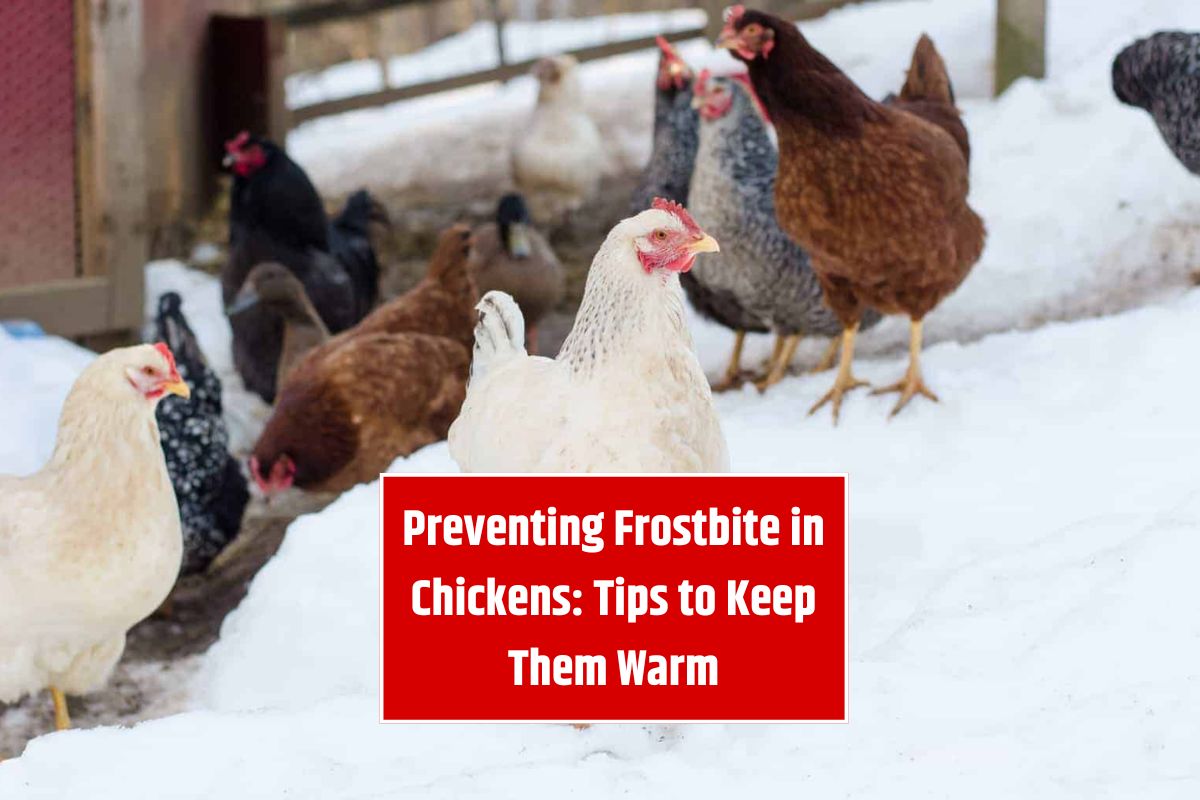Winter frostbite can cause serious health issues for chickens, ranging from discomfort to permanent damage. Moisture and reduced blood circulation are the main culprits behind frostbite, but with proper coop maintenance, diet adjustments, and a few practical tips, you can help your flock stay safe and healthy all winter long.
What Causes Frostbite in Chickens?
Frostbite occurs when exposed skin, such as combs, wattles, and toes, freezes due to:
1. Moisture
- Moisture in the coop (from waterers, droppings, or breath) increases humidity, making it difficult for chickens to stay warm.
- When moisture gathers on exposed skin and freezes, blood flow is restricted, leading to frostbite.
2. Reduced Blood Circulation
- Cold stress causes a chicken’s body to conserve energy by restricting blood flow to extremities like the comb and wattles.
- Without proper circulation, these areas are more prone to freezing.
How to Recognize Frostbite in Chickens
- Discolored combs, wattles, or toes (they may appear pale, gray, or black in severe cases)
- Swelling in affected areas
- Blisters or scabs
- Reluctance to walk or perch
Preventing Frostbite in Chickens
1. Encourage Good Blood Circulation
Healthy circulation keeps oxygen and warmth flowing to all parts of a chicken’s body.
Tips to Promote Blood Flow:
- Encourage Movement: Scatter treats like Grubblies (black soldier fly grubs) around the run to get them scratching and pecking. Movement generates body heat and improves circulation.
- Install Perches: Provide perches at varying heights, ensuring their feet are off the cold ground.
- Warm Snacks: Offer warm snacks like oatmeal sprinkled with ground ginger. Ginger is a natural circulation booster.
- Use Circulation-Boosting Supplements:
- Ground ginger root (use in moderation)
- Parsley (safe for regular use)
- Cayenne pepper (use sparingly, as chickens can’t taste spice and may overconsume it)
2. Minimize Moisture in the Coop
Reducing moisture is key to preventing frostbite, as high humidity levels increase the likelihood of frozen combs and wattles.
Tips to Reduce Moisture:
- Use Closed Water Systems: Install nipple waterers or closed water containers to minimize open water surfaces.
- Move Waterers Outside: Keep water sources outside the coop to prevent spills and reduce indoor moisture.
- Clean Droppings Regularly: Chicken manure contains moisture, so clean the coop daily or use the deep litter method to compost droppings and absorb moisture.
- Use Absorbent Bedding: Hemp bedding is excellent for absorbing moisture while providing insulation.
3. Ensure Proper Coop Ventilation
Good ventilation removes moisture-laden air, preventing condensation on combs and wattles.
- Install vents near the roof: Moist air rises and can escape through vents while fresh air flows in.
- Cover vents with hardware cloth: Prevent predators while allowing airflow.
- Avoid drafts: Ensure ventilation is high enough that cold air doesn’t blow directly on the chickens.
4. Winterize the Coop and Run
Protect your flock from cold winds, snow, and ice, which can speed up frostbite development.
- Cover the run with weatherproof material: Tarps or plastic sheeting can block wind and snow.
- Use straw or hemp for ground insulation: This prevents frostbite on toes when chickens walk or dust bathe.
- Provide windbreaks: Block the windiest sides of the coop or run.
5. Apply a Protective Salve
Salves provide a moisture barrier and protect sensitive areas from freezing.
- Use a beeswax-based salve: Beeswax is ideal for preventing moisture buildup, unlike oil-based salves, which can trap moisture.
- Apply on combs and wattles before extreme cold or windy days.
Tip: Roosters often dip their wattles into water while drinking, increasing their risk of frostbite. Apply salve more frequently to roosters.
6. Prevent Cold Stress
Cold stress leads to restricted circulation and increases the risk of frostbite.
Tips to Reduce Cold Stress:
- Use the deep litter method: Composting litter generates natural heat.
- Increase protein intake: Offer high-protein snacks like Grubblies to provide extra energy for staying warm.
- Provide warm, enclosed spaces: Create cozy corners in the coop with plenty of dry bedding.
Managing Chicken Droppings to Reduce Moisture
Since chicken manure has high moisture content, effective droppings management is crucial.
Methods to Manage Droppings:
- Droppings boards or trays: Place them under roosts to collect overnight droppings, making cleanup easier.
- Deep litter method: Allow droppings to compost within absorbent bedding. Composting generates heat and minimizes moisture.
Choose Cold-Hardy Chicken Breeds
If you live in a region with harsh winters, consider adding cold-hardy breeds to your flock.
Characteristics of Cold-Hardy Breeds:
- Small combs (pea comb, cushion comb, or walnut comb)
- Feathered feet and legs for extra protection
- Dense plumage for insulation
Examples of Cold-Hardy Breeds:
- Wyandottes
- Orpingtons
- Brahmas
- Ameraucanas
- Plymouth Rocks
What to Do If a Chicken Has Frostbite
Mild Cases:
- Move the chicken to a warm, dry area.
- Apply a warm (not hot) compress to the affected area for 15-20 minutes.
- Apply an antibiotic ointment to prevent infection.
Severe Cases:
- Contact a veterinarian.
- Do NOT rub or massage the affected area, as this can cause further damage.
Preventing frostbite in chickens requires a combination of moisture control, proper circulation, coop ventilation, and cold-weather care. By following these tips, you’ll help ensure your flock stays healthy, warm, and frostbite-free all winter.











